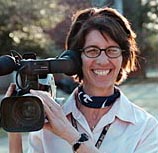The location set of a motion picture is a very busy place. While some productions give tv crews access for "behind the scenes" footage, and time for interviews, others maintain "closed sets." It's a trade-off between publicity and time taken away from production. When Kevin Costner was on location near Gallisteo, New Mexico shooting "Wyatt Earp," ABC News asked me to shoot an interview with writer/director Larry Kasden for a program on movie violence. We arrived early at the movie ranch known as the Cook Ranch, sought the help of the publicist for permission to stake out a good looking shot in the OK Corral set, and waited. Kasden was shooting a "master" shot in which Wyatt Earp and his brothers walk across the street into a bar. A horse-drawn buckboard crossed behind the characters from right to left, and two riders rode up from left to right, followed by the cowboy-actor Boots Sutherland, who loped through the shot on a black horse, wearing a black cape. At the same time, on a different street of the movie ranch (also known as the Silverado Ranch), a grip crew was laying dolly track that was needed for a re-shoot of a shot from the day before. Time is crucial on the location set of a motion picture, and because the director is the busiest person on the set, it was important for us to be set up and ready. We television folks need to look out for possible distractions, and deal with them in advance. Our sound technician, Hal Bowers noticed a forklift moving lumber, and went to speak with the construction crew about holding the work while we would be shooting. After a few minutes, Hal reported back. This is what crew chief told him: "We're building a softball field for Kevin. It's more important than the movie, and it's more important than ABC, and it's more important than you." Kevin Costner liked to play ball with the grips during lunch, and being the leading man he enjoyed the prerogative of being the pitcher. As it happened, the sound was not a problem,
and the interview went well. And we learned something about the relative
importance of a network television crew on a movie ranch.
 Amy Bowers
|
